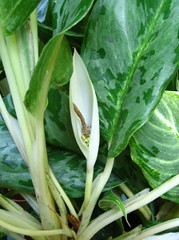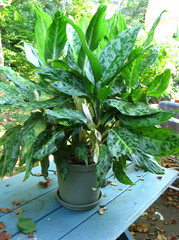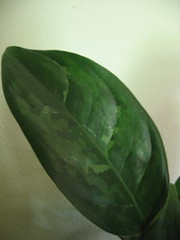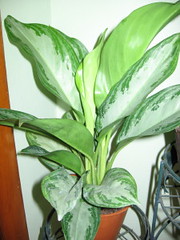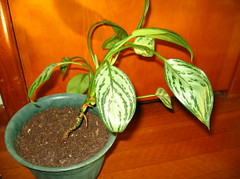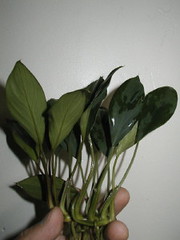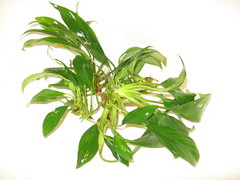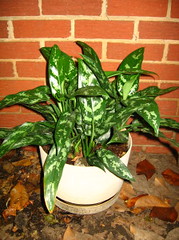I’ll start from the basics. The word propagation can mean several different things. In the context of meteorology, we use the word "propagate" to describe the movement of certain weather properties of interest. In the context of plants, the word “propagation” refers to producing new plants from one of a number of different sources (i.e., seed or clipping).
I think my interest in propagation is three-fold:
Some of the more simple forms of propagation include starting plants from seed or corm/rhizome/bulb separation. This separation technique is much like division except that rhizome separation often requires cutting a rhizome into pieces, which is a scary step for someone who has a plant they want to multiply, not kill. Irises can be propagated by simply cutting the creeping rhizome into pieces. Conversely, tulip bulbs can simply be separated when new bulbs are formed each year.
There are some more advanced techniques that I may try eventually, but first I need to master (or at least have some limited success) with the more primitive forms of propagation. Some advanced techniques are tissue culture (micro propagation) and grafting. Tissue culture is used extensively in the nursery business, so I am told. It sounds a little complicated, but it turns out that it is not much of a mystery at all. Grafting is a common technique used for rose gardening and for fruit trees. It can be accomplished by removing a single bud from the desired rose/fruit parent plant. Then a special inverted-T shape incision is made in the host plant to hold the bud. The bud is secured in place and the plant is watered as normal. A successful grafted bud will begin to grow in about a week. An unsuccessfully grafted bud will turn black pretty quickly.
I’ll be posting again soon, chronicling “My Attempts at Propagation.” Stay tuned!
I think my interest in propagation is three-fold:
1. I would like to have more plants without buying them,
2. it’s a fun challenge and
3. the science is intriguing to me.
There are a number of methods for propagating plants. The most simple is probably division. Many plants will reproduce underneath the soil, sending off runners and developing new plants. In this case, you can divide these plants by pulling the roots apart and separating the individual plants. Many times a plant can even be successfully divided by cutting a large root ball apart. This works well for: mature asparagus ferns, aglaonemas, wandering jew, moneywort, etc.
Another simple method of propagation is to root soft cuttings in a vase of water. Some plants that this works well for are: again wandering jew, pothos ivy, many philodendrons, lipstick plant, and pineapples.
The technique of layering deals with forcing roots to form along the stem of a plant and then removing that section of plant when the roots are mature enough to support the section without the mother plant. Did that make sense? One way of doing a layer propagation is called air-layering. It’s a neat concept that I have tried many times, with no success. First, a set of leaves is removed from a softwood stem of a plant, bush or tree. [By the way, softwood is often defined as an area of new growth that would make a “snapping” sound if you were to break it]. Next, an incision is made in the stem at this location. It is best to apply rooting hormone to the wound. (Of course, I have never had a successful rooting, so what do I know about what’s best!?!) A toothpick (or a piece of one) can be inserted in the cut to hold it open, and other toothpicks may be used as a splint, to hold the stem together (as if it were a broken bone). Lastly, the area should be wrapped in plastic with moist peat moss inside. This dressing allows the entire plant to support the section of plant which has been wounded, while encouraging roots to form in the peat moss. Here is a good website with instructions and visualizations.
There are a number of methods for propagating plants. The most simple is probably division. Many plants will reproduce underneath the soil, sending off runners and developing new plants. In this case, you can divide these plants by pulling the roots apart and separating the individual plants. Many times a plant can even be successfully divided by cutting a large root ball apart. This works well for: mature asparagus ferns, aglaonemas, wandering jew, moneywort, etc.
Another simple method of propagation is to root soft cuttings in a vase of water. Some plants that this works well for are: again wandering jew, pothos ivy, many philodendrons, lipstick plant, and pineapples.
The technique of layering deals with forcing roots to form along the stem of a plant and then removing that section of plant when the roots are mature enough to support the section without the mother plant. Did that make sense? One way of doing a layer propagation is called air-layering. It’s a neat concept that I have tried many times, with no success. First, a set of leaves is removed from a softwood stem of a plant, bush or tree. [By the way, softwood is often defined as an area of new growth that would make a “snapping” sound if you were to break it]. Next, an incision is made in the stem at this location. It is best to apply rooting hormone to the wound. (Of course, I have never had a successful rooting, so what do I know about what’s best!?!) A toothpick (or a piece of one) can be inserted in the cut to hold it open, and other toothpicks may be used as a splint, to hold the stem together (as if it were a broken bone). Lastly, the area should be wrapped in plastic with moist peat moss inside. This dressing allows the entire plant to support the section of plant which has been wounded, while encouraging roots to form in the peat moss. Here is a good website with instructions and visualizations.
There are other forms of layering, as well. Regular layering (sometimes called mound layering) is accomplished by building up the dirt around the base of a plant or bush and running several branches of the bush through the mound. Some plants will freely begin to produce roots at nodes along the buried branch or stem. Other plants require the extra encouragement of a wound and some rooting hormone.
Some of the more simple forms of propagation include starting plants from seed or corm/rhizome/bulb separation. This separation technique is much like division except that rhizome separation often requires cutting a rhizome into pieces, which is a scary step for someone who has a plant they want to multiply, not kill. Irises can be propagated by simply cutting the creeping rhizome into pieces. Conversely, tulip bulbs can simply be separated when new bulbs are formed each year.
There are some more advanced techniques that I may try eventually, but first I need to master (or at least have some limited success) with the more primitive forms of propagation. Some advanced techniques are tissue culture (micro propagation) and grafting. Tissue culture is used extensively in the nursery business, so I am told. It sounds a little complicated, but it turns out that it is not much of a mystery at all. Grafting is a common technique used for rose gardening and for fruit trees. It can be accomplished by removing a single bud from the desired rose/fruit parent plant. Then a special inverted-T shape incision is made in the host plant to hold the bud. The bud is secured in place and the plant is watered as normal. A successful grafted bud will begin to grow in about a week. An unsuccessfully grafted bud will turn black pretty quickly.
I’ll be posting again soon, chronicling “My Attempts at Propagation.” Stay tuned!
